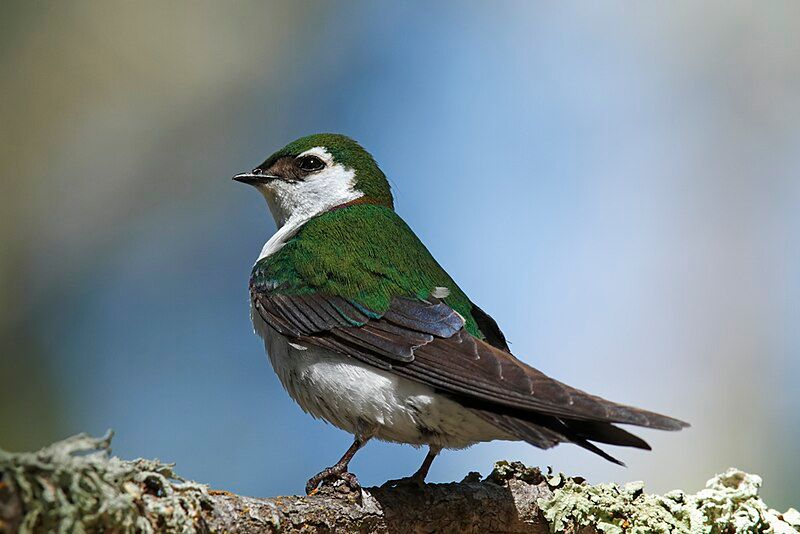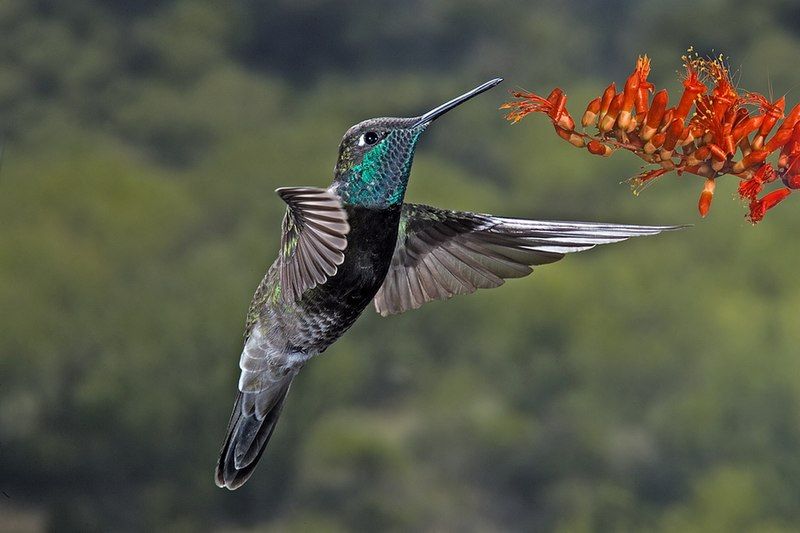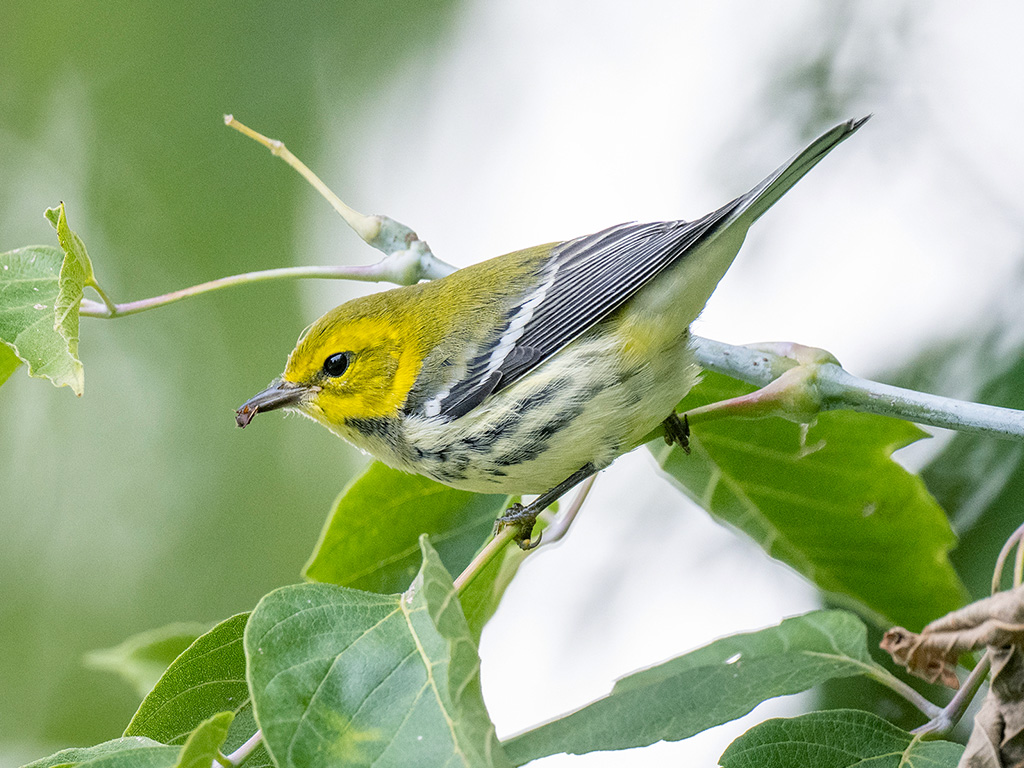South Dakota is home to a variety of green birds, ranging from small songbirds to large waterfowl. These green-hued birds can be found in the state’s diverse habitats, including prairies, wetlands, and woodlands.
Some of the most common species are the American green-winged teal, the mallard, and the wood duck. These species are important to the state’s ecology, as they help to control insect populations, disperse seeds, and provide valuable food resources for other animals.
For those wishing to observe these beautiful birds in the wild, there are a number of state parks and wildlife refuges where they can be seen.
7 Green Birds in South Dakota
South Dakota is a state with diverse habitats and landscapes, from the Black Hills and Badlands in the west to the prairies and lakes in the east. The state is home to many bird species, some of which have green or olive-colored plumage.
Here are 7 of these green birds that you can find in South Dakota.
1. Violet-Green Swallow

The Violet-Green Swallow is a small bird species native to North America. It belongs to the swallow family, which are a type of passerine bird, meaning they are perching birds.
The Violet-Green Swallow is an aerial insectivore, meaning its diet consists of insects that it catches in mid-air. This species is distributed along the west coast of North America, from Alaska down to Mexico.
It can also be found in some areas of the mid-west, such as Montana and Texas. Therefore, its range extends from the northern-most parts of the continent to the southern-most areas. Violet-Green Swallows typically inhabit open woodlands, grasslands, and parks.
They are usually seen in flocks with other swallows, and they nest in tree cavities, rock crevices, and other natural cavities.
They build a cup-shaped nest from mud and grass and line it with soft feathers. These birds are also known for their acrobatic flight patterns, which they perform while hunting for food. They often fly in wide circles, dipping and swooping through the air to capture insects.
They are capable of reaching speeds of up to 35 mph while in flight. The Violet-Green Swallow is an important species to the environment, as it helps to keep insect populations in check.
They are also a popular species for bird watchers and photographers, as their spectacular aerial displays can be quite a sight to behold.
| Kingdom | Animalia |
| Phylum | Chordata |
| Clade | Dinosauria |
| Class | Aves |
| Order | Passeriformes |
| Family | Hirundinidae |
| Genus | Tachycineta |
| Species | T. thalassina |
2. Green Heron
The green heron, also known by the scientific name Butorides virescens, is a small heron found in North and Central America. Its name is derived from two root words, Middle English butor meaning “bittern” and Ancient Greek -oides which means “resembling”.
The second part of its scientific name, virescens, comes from the Latin word for “greenish”, which perfectly describes its greenish color. Green herons are usually found near bodies of water such as rivers, ponds, and lakes.
They feed mainly on small fish, frogs, insects, and aquatic invertebrates. These herons are relatively small, typically measuring between sixteen and twenty-four inches in length. They have a greenish-brown body, a white throat, and a yellow-orange bill.
They also have a distinctive crest on the back of the head, which can be raised and lowered as a form of communication. In addition to being solitary hunters, green herons are also social creatures.
They often congregate in pairs or small groups during the breeding season, which typically occurs from April to August. During the breeding season, males will perform an elaborate courtship dance in order to attract a mate.
The green heron is an interesting and unique bird that has adapted successfully to its environment. It is an important part of the North and Central American ecosystem, where it plays a vital role in regulating the populations of small fish, amphibians, and other aquatic life.
| Kingdom | Animalia |
| Phylum | Chordata |
| Clade | Dinosauria |
| Class | Aves |
| Order | Pelecaniformes |
| Family | Ardeidae |
| Genus | Butorides |
| Species | B. virescens |
3. Green-Winged Teal
The American teal, also known as the green-winged teal, is a widely distributed duck species native to North America. It is found in the northern areas of the continent, with the exception of the Aleutian Islands.
For a period of time, it was believed to be the same species as the Eurasian teal, but this has since been disproven and the American teal is now considered to be its own species. The American teal is a common species, widespread in its range and generally abundant.
It is an important game bird, hunted for sport as well as for sustenance. They are also a popular bird in aviculture, with many captive populations kept in zoos and aviaries.
| Kingdom | Animalia |
| Phylum | Chordata |
| Clade | Dinosauria |
| Class | Aves |
| Order | Anseriformes |
| Family | Anatidae |
| Genus | Anas |
| Species | A. carolinensis |
4. MacGillivray’s Warbler
MacGillivray’s warbler is a species of New World warbler that is known for its sluggish and heavy appearance. Unlike most warblers, these birds prefer to spend most of their time on or near the ground instead of flying high in the sky.
They are often seen walking around on the ground foraging for food such as insects and berries. Despite their grounded lifestyle, they can still be heard singing from high up in the treetops.
This species of warbler typically prefers to live in dense undergrowth and shrubs, where they can hide from potential predators. They are also known to migrate south during the winter months in order to find more suitable climates.
MacGillivray’s warbler is an interesting species of New World warbler that has adapted to its environment and lifestyle in a unique way.
| Kingdom | Animalia |
| Phylum | Chordata |
| Clade | Dinosauria |
| Class | Aves |
| Order | Passeriformes |
| Family | Parulidae |
| Genus | Geothlypis |
| Species | G. tolmiei |
5. New World Warblers
The New World warblers, also known as wood-warblers, are small birds that belong to the family Parulidae. They are typically colorful and can only be found in the New World.
These warblers are not related to the Old World warblers, which are from Europe, Asia, and Africa, or the Australian warblers, which are native to Australia.
The New World warblers have a wide range of habitats, including coniferous and deciduous forests, woodlands, shrublands, swamps, and tundra. They feed on insects and other small invertebrates, as well as on fruits and seeds.
These birds are usually found in flocks and are active during the day. The New World warblers are popular among birdwatchers and nature enthusiasts, as they are usually quite colorful and have a wide variety of songs.
Additionally, they are relatively easy to spot due to their active nature. As a result, they are a great way to observe and appreciate the beauty of the natural world.
| Kingdom | Animalia |
| Phylum | Chordata |
| Clade | Dinosauria |
| Class | Aves |
| Order | Passeriformes |
| Family | Parulidae |
6. Rivoli’s Hummingbird

Rivoli’s hummingbird, also known as the magnificent hummingbird, is a species of hummingbird in the “mountain gems” tribe of Lampornithini, which is part of the Trochilinae subfamily.
This species of hummingbird is native to several countries in Central America and the United States. Specifically, it can be found in El Salvador, Guatemala, Honduras, Mexico, Nicaragua, and the United States.
Rivoli’s hummingbird is a medium-sized hummingbird, typically growing to around 3.75 inches in length. It has a green back and head, with a bright, orange-colored throat and chest. The wings and tail are dark-colored, and the bill is long and thin.
Rivoli’s hummingbird can be found in open woodlands, scrublands, gardens, and other open habitats. It feeds on the nectar from flowers, as well as small insects. It also has a distinctive, high-pitched song that can be heard from up to a mile away.
Rivoli’s hummingbird is a fairly common species, and its population is believed to be stable. However, its habitat is threatened by deforestation, development, and other human activities.
Conservation efforts are underway to protect its habitat and ensure the species’ continued survival.
| Kingdom | Animalia |
| Phylum | Chordata |
| Clade | Strisores |
| Class | Aves |
| Order | Apodiformes |
| Family | Trochilidae |
| Genus | Eugenes |
| Species | E. fulgens |
7. Black-Throated Green Warbler

The black-throated green warbler is a member of the family of birds known as New World warblers. They are small, insectivorous birds, typically found in North America and parts of Central America.
The species is easily identifiable by its distinct black throat and bright green back. The bird’s diet consists mostly of small insects, such as caterpillars and beetles, as well as berries and fruits.
During the breeding season, the male black-throated green warbler can be heard singing its complex song from the trees. They prefer to nest in dense undergrowth, such as shrubs, saplings, or tangles of vines.
The bird is a common sight in forests throughout the eastern United States, as well as parts of Canada and the Caribbean. It is also listed as a species of “Least Concern” on the IUCN Red List of Threatened Species, meaning that it is not considered to be at risk of extinction.
| Kingdom | Animalia |
| Phylum | Chordata |
| Clade | Dinosauria |
| Class | Aves |
| Order | Passeriformes |
| Family | Parulidae |
| Genus | Setophaga |
| Species | S. virens |
Conclusion
Green birds are not a common sight in South Dakota, but they do occasionally make an appearance. The most common green birds to be seen in the state are the American Goldfinch, the Baltimore Oriole, and the Cedar Waxwing.
While sightings are not frequent, they are still possible in some parts of the state. It is important for birders to keep an eye out for these beautiful creatures and to document their sightings for the benefit of future generations.